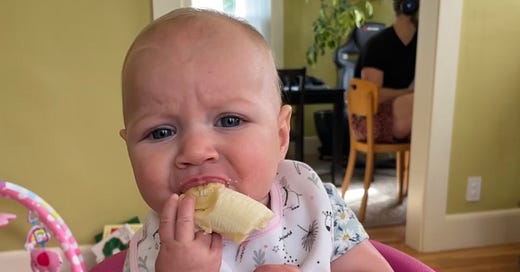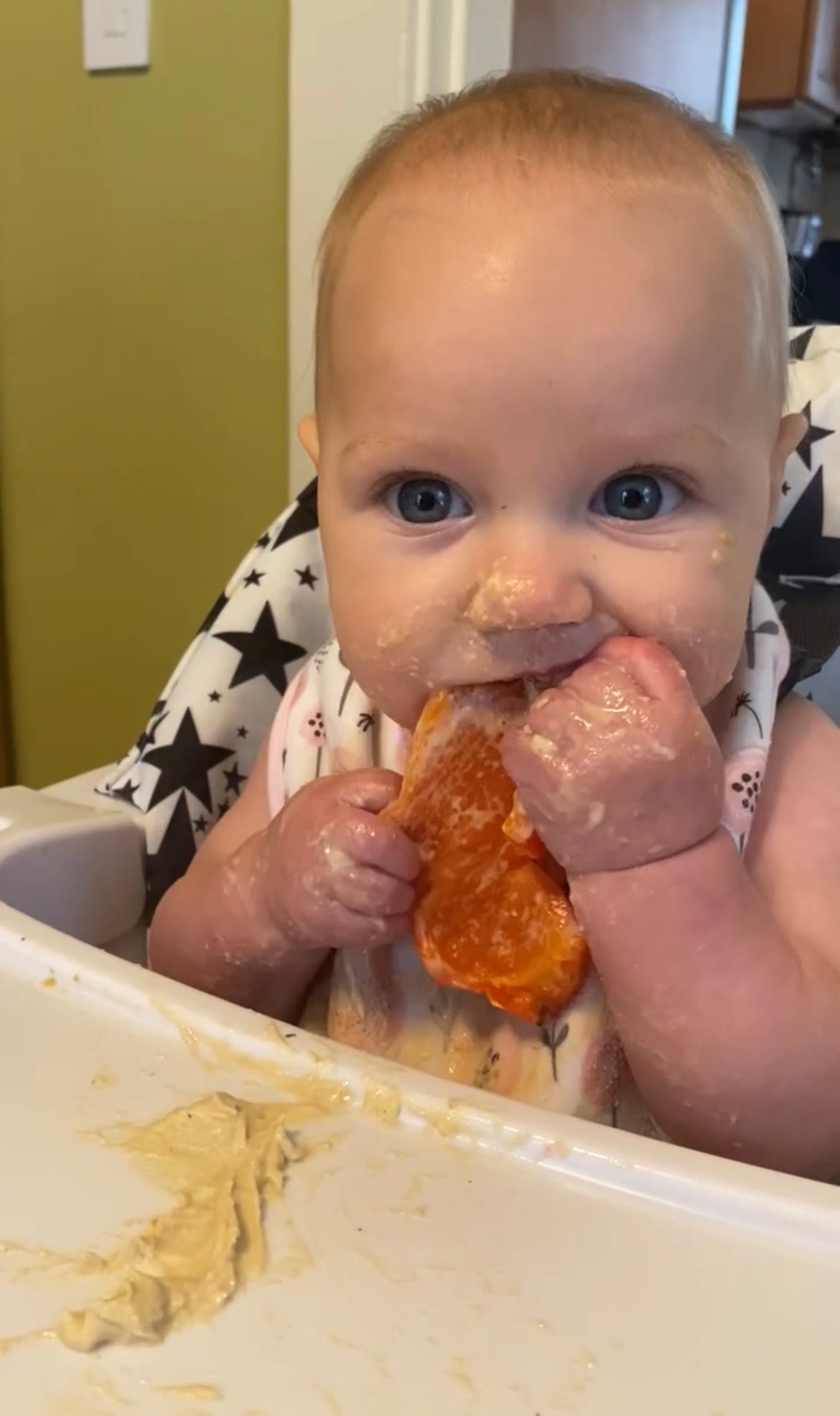As a nutrition coach, I've always been passionate about fostering a healthy relationship with food. When I became a mom, I knew I wanted to also try my best to support a positive relationship with food for my new daughter. Certainly there is no fool-proof method to preventing picky eaters, or “making” kids like vegetables, but after doing research, we decided that Baby Led Weaning (BLW) was the path we wanted to try when it was time for Beatrix to start eating solid foods at 6 months old. This is certainly NOT the only option in helping kids develop healthy eating habits and learning skills, and it may not be right for your family or child, but this is the one we picked. I’m also not an expert in infant nutrition by any means, so simply take this as my own experiences and one option to consider if this applies to your life!
So far, this approach has been a rewarding adventure, filled with both triumphs and challenges. We started BLW when Beatrix was 6 months old, and simply started letting her experience one food at time. Those individual foods led to baby-appropriate meals, at 8 months she was eating two meals a day, at 10 months she was having 3 meals, and now, at 13 months old, she’s having 3 meals and 2 snacks a day. She’s still breastfeeding in the morning and at night, but I don’t imagine she gets much of her sustenance from that and that it’s more a habit or comfort at this point.
Now, I'll share our experiences, the pros and cons of BLW, and why it might be a great option for you to consider for your little one (or use the same kinds of strategies for older children or even adults!).
First of all, What is Baby-Led Weaning?
Baby-led weaning is a method of introducing solids that allows babies to feed themselves from the very beginning of their journey with solid foods. Instead of spoon-feeding purees, I offered my daughter whole pieces of food that she could grasp and explore on her own. This method promotes independence, fine motor skills, and a healthy relationship with food.
Here’s my little honey with some of her first foods, banana and roasted red peppers with hummus:
Is it messy?! Goodness, yes! So you definitely have to be ready to embrace the mess if you choose this route!
Is it nerve-wracking at times? Also, yes. Watching babies gag on food—like they’re supposed to so they don’t choke!—was so anxiety inducing. Staying calm while they figure it out was a challenge at times, too, but now Bea manages food very well!
Why We Chose Baby-Led Weaning
I was drawn to BLW because it aligns with my philosophies around food, and also respects a child's natural hunger and fullness cues. Plus, I loved the idea of my daughter being an active participant in her eating process. Here are some reasons why you might consider BLW:
Promotes Independence: BLW allows babies to control what and how much they eat, fostering self-regulation, and the noticing of hunger and fullness cues.
Supports Motor Skill Development: Handling different shapes and textures helps develop fine motor skills and hand-eye coordination. It’s crazy to watch these skills develop over time, too!
Encourages Exploration: Babies get to experience a variety of tastes and textures, which can lead to a more adventurous eater. As mentioned above, BLW can reduce picky eating, but it’s not a guarantee! More research is being done on this, but so far it seems that pickiness may be reduced with BLW and that exposure to foods early in life can lead to more openness with foods in the future.
Support with Exposure To Allergens: It’s recommended that kids are exposed to allergens like peanuts, fish, dairy, eggs, etc early and often in their eating journeys. I appreciated the fact that the courses we took on BLW guided us on how to expose to allergies in an appropriate way and what to look for after eating them, etc.
Our Baby-Led Weaning Journey
Starting around 6 months old, Bea showed signs of readiness: she could sit up with minimal support, was definitely interested in our food, and had the motor skills to grasp and bring food to her mouth. We began with soft, easy-to-hold foods like steamed vegetables, ripe fruits, and soft-cooked meats.
Here were our first 10 foods:
Banana
Oatmeal
Steamed Apple
Eggs
Yogurt
Avocado
Black Beans (Which still remain a top 5 favorite food to this day!)
Raspberries
Broccoli
Sweet Potato
We tried each of these on a different day and followed guides on how to serve them in an appropriate manner for her age. Over time, as mentioned above, single foods turned into meals, and then multiple meals per day. At first we were feeding her some different things than we were eating, or served in different forms, but now she generally is served what we eat, as appropriate for her. This is super helpful because I just cook or prepare one meal and she eats that with us!
She ate 100 different foods before she was 1! There are certainly foods she doesn’t prefer, but we let her pick and choose what and how much she wants to eat, and aim to make sure there is at least one thing we know she does like and enjoy on her plate at each meal.
Pros and Cons of Baby-Led Weaning
Pros:
Autonomy: Babies learn to regulate their own intake, which can promote healthy eating habits and tuning into hunger cues.
Motor Skills: Encourages the development of fine motor skills and hand-eye coordination. At first she was only using her whole hands to grasp large pieces of food or spoons. Now, she can pick up smaller pieces of food and is even starting to use a fork/spoon to scoop food from her plate.
Family Meals: Babies can eat the same foods as the rest of the family, making mealtime more inclusive.
Cons:
Choking Hazards: Parents need to be vigilant about choking risks and ensure foods are cut appropriately. This can certainly be nerve wracking, as mentioned above, but, again, the classes I took present guides on age-appropriate food sizes and how to prepare them to make them edible for your child. Admittedly, we did have a two instances when Bea needed help dislodging food, but she was unfazed by it and went back to eating after we helped her.
Messiness: BLW can be messy, as babies explore and play with their food. After many meals, there is food all over them, the floor, the wall, and you. Over time this shifts, and some foods are messier than others, but this is definitely part of this process.
Nutritional Balance: Ensuring that the baby receives all necessary nutrients, particularly iron, can require careful planning. This is because you’re serving actual foods as opposed to baby foods which include certain nutrients that babies need extra of; it’s not impossible, but does require work to make sure they’re getting what they need.
Despite any cons, I feel really good about where our BLW journey has gotten us today. Here are some more recent photos. One is after she finished a whole plate of gnocchi and meatballs, the other is her devouring her taco bowl, which is one of her favorite meals!
Girlfriend has a pretty great appetite, and that also translates to regular bowel movements, which is good for her too!
We also taught her how to use sign language to tell us when she wants “more” and when she’s “all done.” You can do this regardless of how you eat with your child, and I highly recommend it, as it’s been super helpful to us!
Resources for Baby-Led Weaning
If you're interested in trying BLW, there are plenty of resources to help you get started:
Courses: Feeding Littles and Solid Starts were the ones we took and found extremely helpful! These are also great accounts to follow on social media as they post helpful tips, recipes, and nutritional perspectives to help you on your journey.
Books: "Baby-Led Weaning: The Essential Guide" by Gill Rapley and Tracey Murkett is a comprehensive resource.
Websites: The Baby-Led Weaning website (babyledweaning.com) offers tips, recipes, and a supportive community.
Communities: Join online forums or social media groups for support and advice from other BLW parents.
Conclusion
Our journey with baby-led weaning has been an incredible experience. It has empowered my daughter to explore and enjoy food at her own pace while fostering a positive relationship with eating. If you're considering BLW, I encourage you to give it a try. Embrace the mess, celebrate the milestones, and enjoy watching your little one discover the joys of food.
Have you tried baby-led weaning with your child? Share your experiences in the comments below! Or, what questions do you have that I didn’t address? As away!
As always, thank you for reading,
Sara
PS—Some of the links above are affiliate links.







